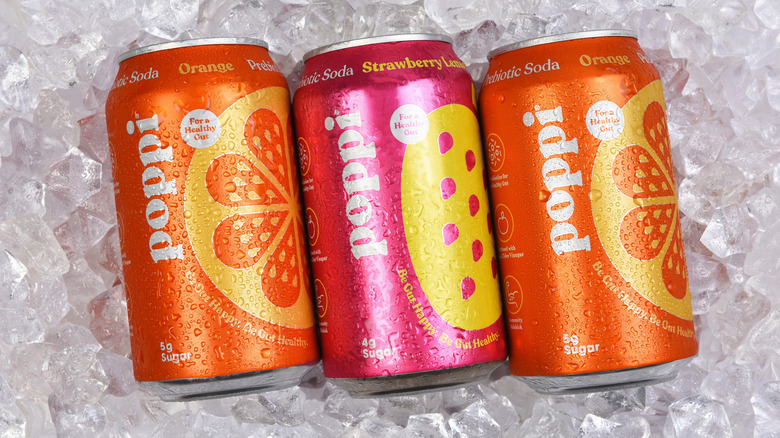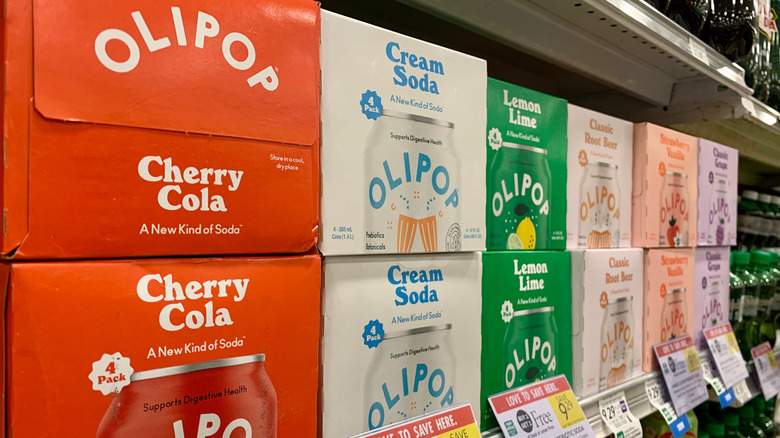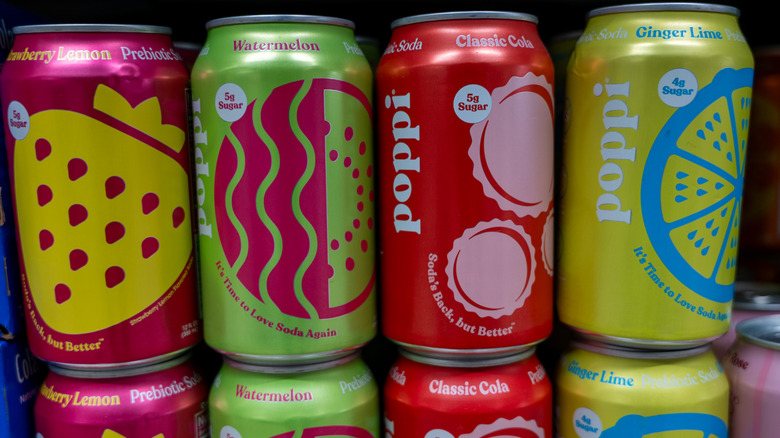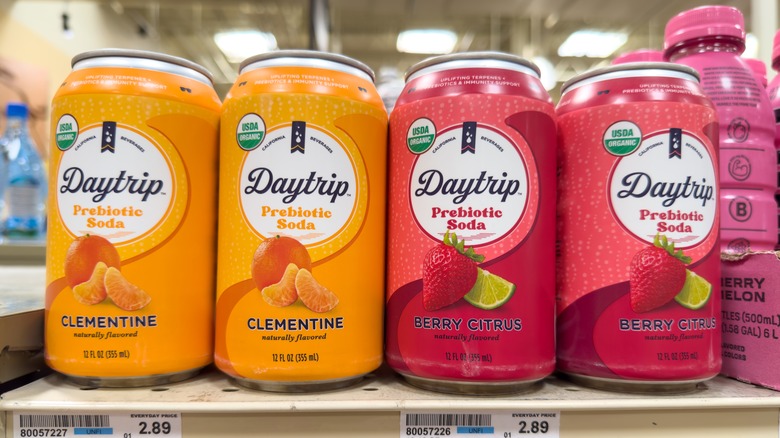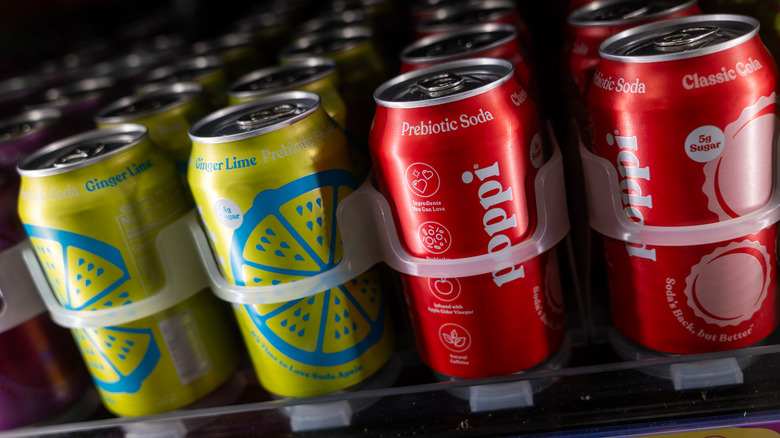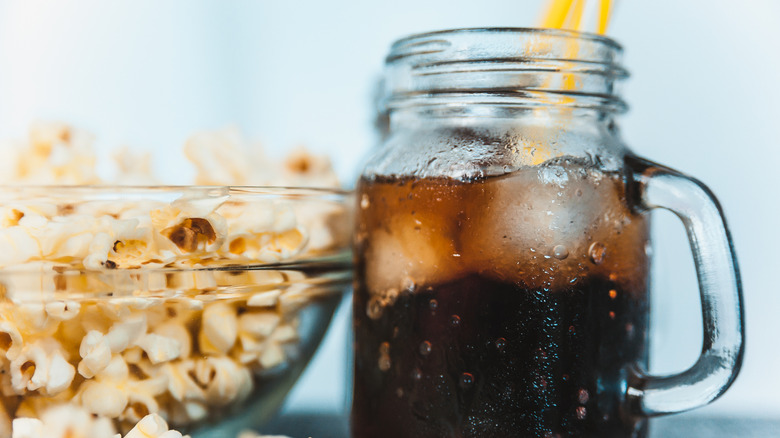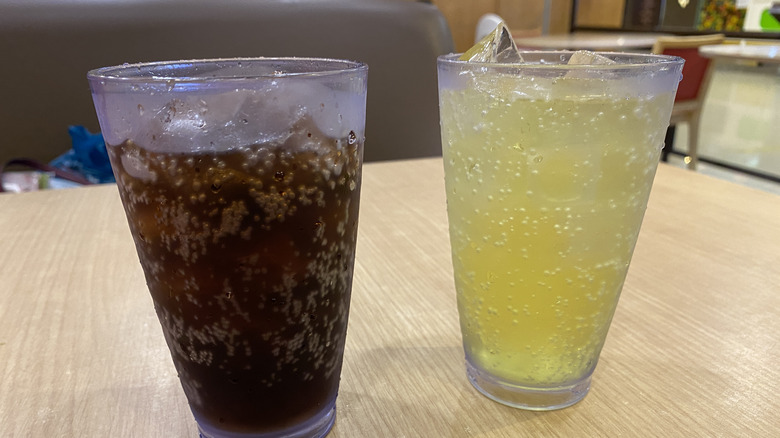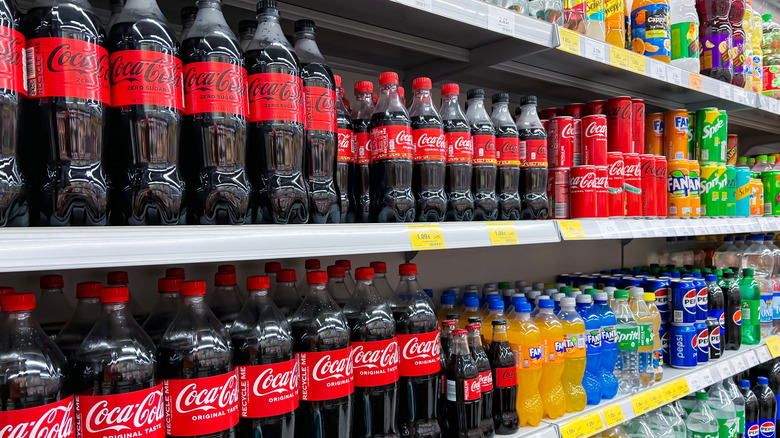Everything You Ever Wanted To Know About Prebiotic Soda
We love sweet, fizzy soda, but as grownups, we know they don't always love us back. Not only is the high sugar content of classic soft drinks terrible for our teeth, but it wreaks havoc on our bodies in a disturbingly large number of ways. For one, it floods our systems with high-calorie sugar without making us feel full, so we continue eating despite the influx of calories. It also promotes the formation of belly fat and is thought to promote Type 2 diabetes. And if you can't stop drinking it despite knowing all of this, well, you may be among the unlucky ones who find the sugar high addictive.
But what if you could create a soda that not only satisfied your cravings but was also good for you? This is where prebiotic soda comes in. The first version of the drink, now sold as Poppi, emerged as a home cooking experiment by Allison Ellsworth, who wanted a tastier way to enjoy the health benefits of apple cider vinegar. She and her husband began to sell their fruity concoction in bottles in local farmers' markets and later in supermarkets. But it was an appearance on "Shark Tank" –- and the $400,000 investment that followed –- that launched them into the mainstream and spawned a flood of copycats. To guide you through the world of prebiotic sodas are registered dieticians Destini Moody of Top Nutrition Coaching and Lena Bakovic of Live It Up.
What is prebiotic soda?
The first thing to know to understand prebiotic soda is that prebiotic is not the same thing as the more familiar term probiotic. "In simple terms, probiotics are good/beneficial bacteria naturally present in certain foods and also found in the form of probiotic supplements in capsule or tablet form," Lena Bakovic explained. "Probiotics help to optimize gut health by balancing the gut flora and presence of beneficial bacterial load."
To flourish in the gut, however, probiotic organisms need food, and the vegetable fibers that feed them are called prebiotics. "This fiber operates in the body by serving as food for the beneficial bacteria in the gut that, when present, can allow this good bacteria to multiply and thrive for even more optimal gut health," Destini Moody explained. Prebiotic soda, then, is soda that contains prebiotic fiber, typically from plants such as agave and cassava. In principle, prebiotic soda aids digestion by giving your gut biome more of the fuel it needs to thrive.
How is prebiotic soda made?
The not-so-secret ingredient that distinguishes prebiotic soda from regular soda is prebiotic fiber –- that is, types of plant-based fiber known to be a food source for probiotic organisms in the digestive system. The most common types of fiber in these sodas are inulin fibers from agave or chicory root. Jerusalem artichoke is another common fiber source. Because inulin is water soluble, it's not visible in the soda, which will drink like any other fizzy beverage –- so no worries, you won't be choking down a mouthful of grit if you try it.
Like other sodas, prebiotic sodas start with a sparkling water base. But because they're marketed as healthy drinks, they often use natural, no- or low-calorie sweeteners such as stevia or monk fruit rather than sugar and get their flavor from fruit juice concentrates, which can include mango, strawberry, citrus, and more. In addition, Lena Bakovic notes that some varieties enhance their health benefits further with the addition of vitamins, minerals, and antioxidants.
Prebiotic soda vs. prebiotic supplements
Prebiotic soda falls into the class of drinks known as functional beverages –- those whose primary purpose is to provide health benefits beyond basic nutrition. These can include anything from old-school sports and meal-replacement drinks to yogurt-based probiotic drinks and vitamin-laced waters and juices. They have proven popular among health-conscious people who know their diets aren't ideal. So if you've been feeling as if your digestion has been a bit off but you don't have the time or energy for a diet overhaul, switching out a regular soda for a prebiotic soda may be an easy and beneficial alternative.
Just as convenient, however, are prebiotic supplements, pills that contain the same types of prebiotic fiber found in sodas. But just as not all prebiotic sodas are created equal, neither are all supplements. To see any benefit, you'll need to consume at least three grams of prebiotic fiber a day, so check labels on both supplements and sodas carefully, since not all deliver on their promise. However, as Destini Moody notes, if you are going to have a soda anyway, a prebiotic soda is a better choice. "Any product that encourages higher fiber intake is hard to sneeze at, especially considering most Americans do not consume the daily recommended amount," she said.
What does prebiotic soda taste like?
Prebiotic sodas now come in a large range of flavors, so it's impossible to define a single flavor profile for all of them. Because many of them contain zero-calorie natural sweeteners such as stevia, you can probably expect a different quality of sweetness than that provided by sugar. And while many lean into natural fruit flavor profiles and aim to taste like sparkling fruit juice, others are prebiotic versions of traditional soft drinks, such as cola and cream soda.
The big question, however, is whether the featured ingredient –- the prebiotic fiber –- impacts the taste of the drinks. While this fiber is water soluble and typically tasteless, some drinkers do notice it. "Cassava root, chicory root, Jerusalem artichoke, and agave inulin are the most common types of fiber seen in the most popular soda brands," Destini Moody explained, "and, having tried quite a few of them, they often do affect the taste. However, brands are getting better and better at creating combinations of flavors and sweeteners to make the taste of the fibers almost indistinguishable."
How to serve prebiotic soda
Prebiotic soda is meant to be a more healthful version of regular soda, so can be enjoyed in the exact same way. "Presently there are no specific recommendations for the consumption of prebiotic sodas," Lena Bakovic said. "They can be consumed with or without food, or at any time during the day." Destini Moody added that if the soda has caffeine, know how your body reacts to caffeine late in the day and plan your consumption accordingly.
Also, since the central purpose of prebiotic soda is to enhance gut health by feeding probiotic bacteria, enjoying a prebiotic soda with probiotic foods may enhance its impact. "It's likely optimal to consume prebiotic soda at the same time or around the same time as you may be having probiotic foods," Moody said. "If you're having a Greek yogurt parfait or are snacking on kimchi, washing it down with some prebiotic soda creates a perfect synergy for gut health."
Where to buy prebiotic soda
Prebiotic soda has become such a mainstream product that you can easily find it anywhere you buy regular soda. For instance, a quick web search found that Poppi, the original brand of prebiotic soda, was available at Wal-Mart, Costco, Target, and Publix, as well as in health food stores. In addition, many types of prebiotic soda are available for sale online, either through online stores such as Amazon or through the manufacturers' own sites.
While the placement and packaging of prebiotic soda is pretty much like that of standard soda –- you'll find the same cardboard cases holding typical-looking cans –- one conspicuous difference you won't be able to miss is price. While a 12-pack of 12-ounce cans of Coca-Cola goes for about $8 at Wal-Mart, an eight-pack of 12-ounce Poppi cans goes for twice as much – around $16. This makes it not only pricey for a soft drink but an expensive way to get your dietary fiber. "If one is on a tight budget, they may not be the best choice," Lena Bakovic said. "An alternative option would be consuming a diet rich in fruits and vegetables, which are natural sources of prebiotics. Other food sources of prebiotics include nuts, seeds, and whole grains."
Nutritional value of prebiotic soda
While the specific nutritional value of prebiotic soda varies by brand, the experts agreed that, in general, it's a more healthful option than traditional soda. "From a nutritional standpoint in comparison to regular soda, they are low in calories, [and] usually provide zero added sugars," Lena Bakovic said. And while it may not be the miracle elixir some think it is, Destini Moody said it still has its benefits. "The jury is still out on whether or not prebiotic soda provides long-term benefits as the product is still very new. However, one thing that can be arguably said with certainty is that they are a healthier alternative to regular soda."
In addition, Moody said not all prebiotic sodas contain enough fiber to provide any real benefit. "It's important to note that just because a soda has prebiotics in it doesn't mean it's worth buying," she said. "It is best to choose a brand that contains at least 5 grams of fiber per serving." Conversely, Bakovic warned, the high fiber content of some prebiotic sodas may pose a risk for some consumers. "People with certain conditions such as irritable bowel syndrome (IBS) may need to be aware that prebiotic sodas can be high in FODMAP content, potentially exacerbating symptoms of their condition," she said, adding that drinking these sodas can cause gas and bloating in those with sensitive systems.
Varieties of prebiotic soda
The original prebiotic soda, now sold as Poppi, was a fruity, handmade concoction first sold at farmers' markets as Mother Beverage. Many varieties available now continue to lean into the healthy hippie vibe and feature not just fruity flavors and fiber but added vitamins and mood-enhancing botanicals. Some, like the original Mother Beverage, feature an apple cider vinegar base.
And as the market for prebiotic soda has grown, so has the variety of options. To suit those who still crave a traditional soda, manufacturers now make prebiotic versions of favorites such as cream soda, root beer, and cherry cola, among others. Other varieties emulate dessert flavors, such as peaches and cream. Sweeteners can vary, too. While prebiotic sodas are all lower in sugar than traditional sodas, some employ small amounts of cane sugar (sometimes in conjunction with fruit juice and other natural sweeteners). In contrast, others pride themselves on being sugar-free.
How to store prebiotic soda
A good thing about prebiotic soda is it's as easy to keep around the house as regular soda. While it's tastiest when served chilled, it doesn't have to be stored in the refrigerator. If you don't have a lot of room in your fridge, it's fine to keep it in the pantry. Provided the temperatures in your pantry are fairly cool and even, probiotic soda can maintain its quality for up to a year. And like all sodas, prebiotic soda will lose its fizz quickly once a can is opened, but it will still retain its prebiotic qualities when flat.
The fiber in prebiotic sodas, however, makes them much more sensitive to heat. Extended exposure to hot temperatures (such as storing cases in the garage during the summer) can break down prebiotic fiber and render it less effective. While food scientists have developed a heat-tolerant variety of prebiotic fiber, it's still a fairly new product and not used by all brands, so beware of hot spots when storing away your prebiotic soda.
Prebiotic soda can be a healthier soda choice for kids
Health-conscious parents have long worried about their kids' attraction to junk food. Sometimes, it seems that the more kids love something, the worse it is for their bodies. And it's tough to get a five-year-old to understand that you're taking away their favorite soda out of love, not spite.
To get around this problem, some parents have considered switching to prebiotic soda, which offers similar sweetness, fizz, and color with far less sugar, fewer calories, and the added benefit of prebiotic fiber. But is it safe for kids? In general, yes. If you're trying to get your kids to cut back on regular soda, prebiotic soda can be a good (if pricey) alternative. However, be wary of varieties with caffeine. According to the American Academy of Pediatrics, children under 12 should avoid caffeine altogether, and those between 12 and 18 should restrict their consumption to 100 milligrams a day. Even sugar-free sodas can contribute to insulin resistance, a precursor to diabetes, if heavily consumed. So, if your kids aren't drinking soda regularly now, don't get them started on prebiotic soda.
Pepsi and Coca-Cola have gotten into the prebiotic soda game
As prebiotic soda has grown in popularity, mainstream soda manufacturers began to take notice. No longer a niche product for the health-conscious few who knew what prebiotic meant, it has become a standard option in mainstream snacking culture. And when Olipop's prebiotic root beer officially became the best-selling single-serving root beer in the U.S. in 2023, overtaking A&W's famed classic root beer, it must have felt like a shot over the bow to mainstream soda makers such as Coca-Cola and Pepsi.
Realizing that prebiotic soda was here to stay, they decided they wanted a piece of the action. While continuing to embrace their sugary flagship products, they added prebiotic soda to their portfolios. In 2025, Pepsi announced that it had acquired Poppi, the original prebiotic soda, for $1.95 billion. Around the same time, Coca-Cola introduced its own line of prebiotic soda, Simply Pop, as part of its Simply line of juices. And while classic Coke and Pepsi aren't going anywhere, fans now have more options if they want to take a break from sugary drinks.
